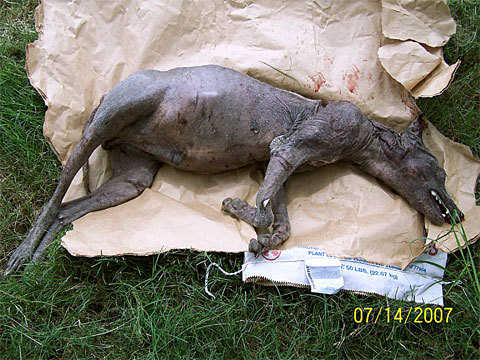Author: Sarah Henagan
The chupacabra, a beast that sucks its victim’s blood and
then liquefies its organs, first “arrived” on the scene in Puerto Rico in
1995. Several farm animals were found
dead from, what was said to be a chupacabra’s exsanguination (blood draining)
via two puncture wounds located on or near the jugular. This started a chupacabra craze as farmers
claimed that the chupacabra killed their livestock. The first sighting of the chupacabra, however,
wasn’t until five months after the first attack. The descriptions after sightings ranged from
unusual to outrageous, and in the end three definitive physical groups of
characteristics surfaced. The first and
best know description is that of a five-foot-tall, two-legged creature with
lengthy claws and an easily recognizable row of spikes running down its
back. The second description is of a
small creature that looks very much like a coyote or dog. The third description is a collection of just
about anything from kangaroos with wings to dead ocean animals (Radford). Typically, though, when people refer to the
chupacabra, they either mean the five-footed, clawed, spiked beast (Type A) or
the dog-like creature (Type B).
 |
| Chupacabra Action figure (Type A) |
 |
| Phylis Canion’s first Chupacabra (Type B) |
Most witnesses can agree on a few things: (1) chupacabras are
incredible jumpers (which explains the statements that they have back legs much
like those of kangaroos), and (2) their eyes glow red as a defense when trapped
and cause nausea and vomiting if you were to look into its eyes directly
(although I cannot fathom how one could corner a chupacabra in fields and
farmlands). If this tactic were to fail,
however, the chupacabra would emit a hiss and produce a deafening scream, then
disappear into the underbrush (Brown).
Since the
first sightings in Puerto Rico, the chupacabra became the third most popular
cryptid (unidentified animal), and the world started hearing reports of the
chupacabra from all over the Spanish and Portuguese speaking countries,
specifically Latin America, Spain, Florida, and Texas (Radford). As expected the investigations came up with
nothing or some common animal, like a dog or a coyote or a mongoose. In 2007, a farmer in Cuero, Texas, found a
strange-looking creature, dead. It had been preying on her chickens and an
occasional cat. She proceeded to freeze
its head, and in 2008 MonsterQuest hosts visited her for an episode on the
chupacabra. They took DNA samples from
the head and had a laboratory analyze them.
The laboratory reported interesting findings: an X chromosome from a
coyote and a Y chromosome from a wolf.
Despite these results, other results from Elmendorf, Texas, and Puerto
Rico were merely dogs with scabies that attacked livestock. (MonsterQuest)
Video of
the most recent chupacabra sighting in Cuero, Texas
Personally I believe that the
chupacabra is real in the sense that unidentified animals are attacking
livestocks; however, I think that the animals result from a coyote-wolf mix, or
perhaps inbred coyotes, or common dogs with mange, or most likely, a
combination of all of them. That is it,
no more and no less. I say this because
if we look at the information given in the eyewitness descriptions, the Type A
chupacabra is highly unlikely to actually exist, whereas Type B chupacabra is
more likely to exist just because that is more likely to occur in real life.
Works Cited:
amcintosh32.
“”Chupacabra” Caught On Tape?” Youtube.com. Youtube.
18 Sept. 2012. Web. 22 Oct. 2012.
Brown, Nathan R.
“Chupacabra.” The Complete
Idiot’s Guide to The Paranormal. New
York, New York: Penguin Group, 2010.
133-134. Books.google.com. Web.
16 Oct. 2012.
Canion, Phylis. Contributed Photo. 2007.
Cuero, Texas. cryptomundo.com. Web.
22 Oct. 2012
Chupacabra Action Figure. n.d. .
Web. 23 Oct. 2012.
CryptoZooKeepa.
“MonsterQuest – Chupacabra.” Youtube.com. Youtube.
20 Jun. 2012. Web. 19 Oct. 2012.
Radford, Benjamin.
Tracking the Chupacabra.
University of New Mexico: Albuquerque, 2011. Print.
Links for Further Research:
Youtube
This is the episode of MonsterQuest that discusses the
history of the chupacabra and details a search for the chupacabra in Cuero,
Texas.
Unexplained Stuff
This is an encyclopedia of unusual, unexplained, and
paranormal things.
Chupacabra Headquarters
This is the official website for the Cuero chupacabra.
I like the scientific slant here; the final paragraph is very rational and doesn't fall into a sensationalist trap.
ReplyDelete